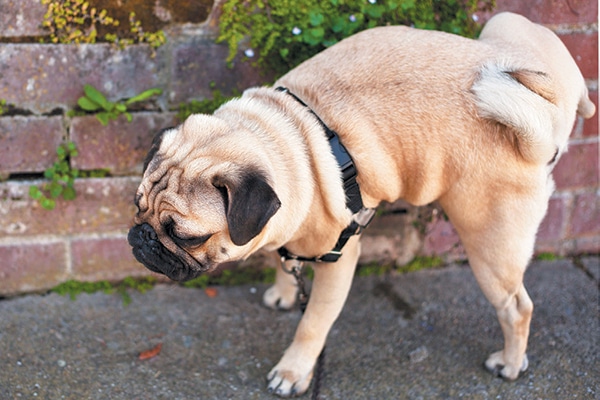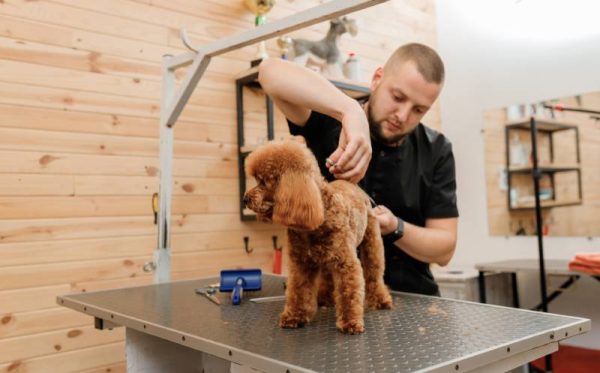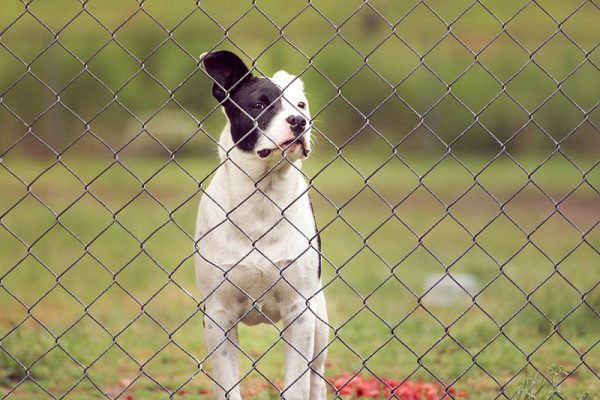In this article
Has it been a while since you noticed your dog urinating very much or even at all? If this is the case, there is a possibility that your dog could be experiencing a urinary tract obstruction, also referred to as a urinary tract blockage. A urinary obstruction is considered a medical emergency and requires immediate action from the dog owner.
In this article, we’ll discuss this condition in more detail, what to do if you suspect your dog has this condition, and some things you may be able to expect at the veterinary office if your dog has a urinary tract obstruction.

What to Do
If you suspect your dog is not urinating very much or think you haven’t seen them urinate at all, try the following steps:
- Think about their normal potty time habits and any changes you’ve noticed lately. In addition, pay attention to whether you’ve noticed them display any signs of a urinary tract obstruction (see below for more information).
- Check that they’ve had access to water; if they have not had normal access to water, they may be dehydrated. This, without any other signs, could explain an alternative, temporary reason why a dog may not have the need to urinate. Reintroducing water should allow for the return of normal urination.
- Attempt to witness their potty breaks first-hand to see if they can pass a normal stream of urine or not.
- Look for evidence that they’ve urinated in other areas. Places that could be enticing may include their bed, crate, blankets, piles of laundry, or areas of carpet that are in quiet, less traveled places in your home. Take a comprehensive look around your home to see if there are any places they may have gone.
- If your dog is truly not urinating, or even if you only suspect this could be the case, being unable to urinate is a medical emergency. Contact a veterinary office or an emergency veterinary hospital right away!
- Follow a veterinarian’s medical advice; a dog who truly cannot urinate will not get better by waiting and they cannot be treated at home without medical intervention. Again, this is an absolute emergency and can prove to be fatal in as little as 2–3 days if not treated promptly.
Did you know you can speak to a veterinarian without having to travel? Just head over to PangoVet. It's our online service where you can talk to a vet online and get the advice you need for your pet — all at an affordable price!

Normal Urinary Tract System Vs a Urinary Obstruction
In a normal dog’s urinary tract system, each kidney makes urine which then funnels into a respective ureter; the ureter allows this fluid to travel from the kidney to a temporary holding place, the bladder. Then, when the fluid is ready to be relieved, the urine travels from the bladder to the genitals to be expelled outside the body via the urethra. If at any point in this process, there is either a partial or full obstruction, the end result will be a lack of urine.
A urinary tract obstruction can be partial, which may make the affected individual urinate very little (such as a few drops), or complete, which would prohibit them from urinating at all. An obstruction can occur anywhere within the urinary tract system, but the most common areas in a dog’s case are within the bladder and/or the urethra.
Urinary Tract Obstruction
Without help and relief from the obstruction, the urine will have nowhere to go and will build up within the body. In some cases, the bladder can rupture, which then releases urine into the abdominal cavity and can result in a dog becoming extremely ill. Regardless of whether a bladder ruptures or not, when a dog cannot expel urine, their urinary waste products (such as potassium) build up within the body.
These high levels of waste products can cause other health problems such as abnormal heart rhythms, further adding to their conundrum. Overall, if untreated and not quickly relieved, a full urinary obstruction will lead to eventual death within a few days.
Male vs Female
This medical condition can occur in both male and female dogs, although it is more commonly seen in males due to their unique anatomy. Male dogs have a longer and narrower urethra (the tubed passageway that brings urine from the bladder to the outside world) that also travels through the os penis bone (baculum). In contrast, female dogs have a wider and shorter urethra which allows more room for the urine to flow out.
They also do not have an os penis bone, which in male dogs often serves as a bottleneck that can restrict urine blockage in the urethra even easier than with females.
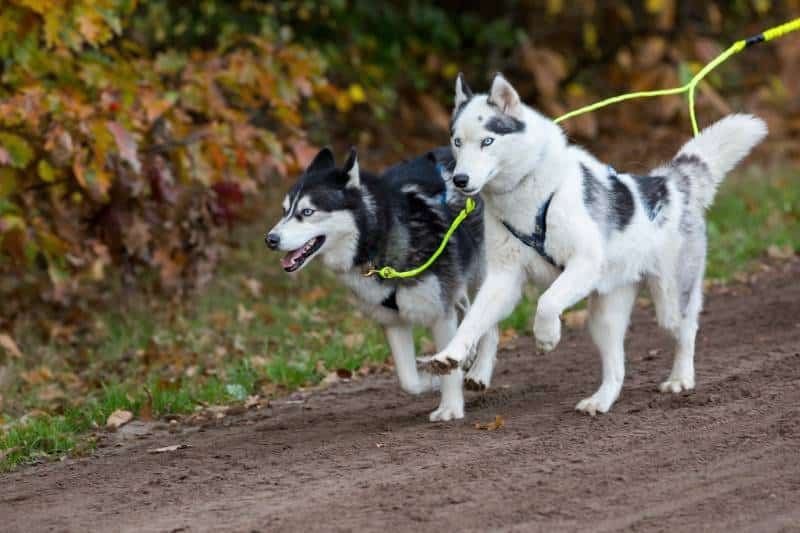
Urinary Obstruction Signs
What can you expect to see if your dog has a urinary obstruction? It may depend on whether there is a partial or full urinary obstruction as well as the location of the obstruction. If your dog is affected, here are some signs you may observe:
- Wanting to go outside more often.
- Taking longer than normal or acting distressed when trying to urinate.
- Posturing or straining to urinate frequently.
- Lack of a stream of urine; there may be very little (such as few drops) or no urine actually coming out.
- What urine is present may be bloody.
- Crying, whining, or vocalizing while attempting to urinate.
- Urinating in abnormal places.
- Abdominal pain.
- Painful and large, distended abdomen.
- Lethargy.
- Not wanting to eat or drink.
- Vomiting.
- Being in pain.
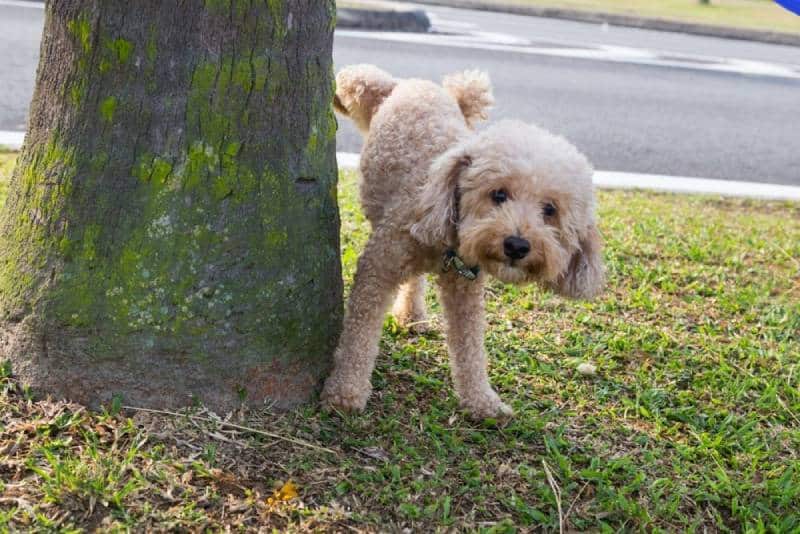
What Are the Causes?
There are various potential causes for urinary tract obstruction, including:
- Urinary calculi, also referred to as urinary tract stones. This is the most common cause in dogs and can occur anywhere along the urinary tract, with the most common being stones that form in the bladder that then move and get stuck in the urethra.
- Inflammation in the urinary tract. If present in the bladder, this is termed cystitis.
- Infection.
- Blood clots.
- Mucous plugs.
- Cancer, such as a tumor that grows large enough to impede the process of urination.
- An enlarged prostate gland in male dogs.
- Spinal cord injury or other trauma.

What to Expect at the Veterinary Office
Diagnosis
To start, a full history and a complete physical exam will be completed by the veterinarian. For a dog unable to urinate, there may be a hard, full, and painful bladder that they are able to feel (palpate). Bloodwork to evaluate kidney damage and electrolyte changes, such as potassium values, is key to determining where a dog is at in the severity of their illness.
In addition, imaging is used to help determine what and where the cause might be. Radiographs (X-rays), sometimes with contrast, can be helpful in showing certain kinds of stones, while ultrasound imaging may be more helpful in showing stones that don’t show up on X-rays, blood clots, or tumors. An electrocardiogram (ECG) that measures the electrical activity of the heart can be important since high levels of potassium can cause irregular beating of the heart.
In addition, sampling the urine with various tests such as looking for an infection or crystals with a urinalysis and urinary culture is very important.
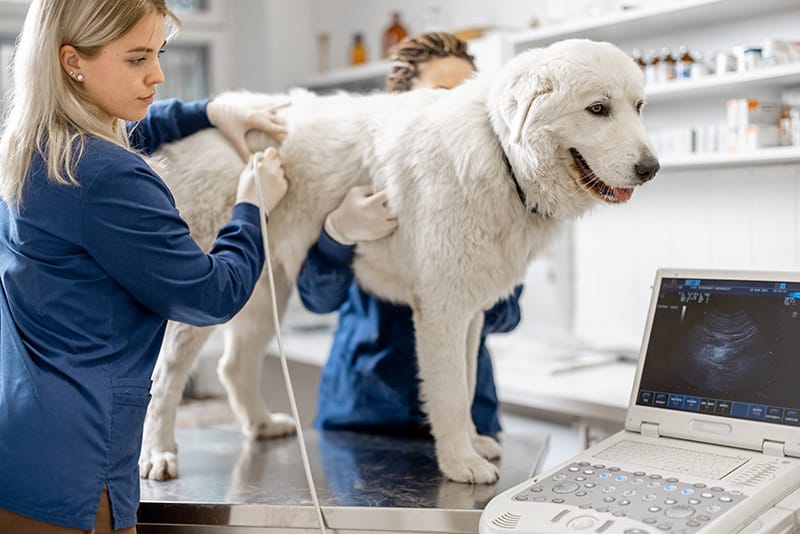
Treatment
The sooner treatment begins, the better chance of recovery and survival your dog will have. Once diagnosed, stabilization would include intravenous (IV) fluids to help with dehydration, kidney function, and electrolyte abnormalities. Because this is a painful medical condition to endure, pain medication is also given for relief. If an infection is found, antibiotics will be administered to resolve this.
Sometimes medication for inflammation, electrolyte changes, etc. will also be needed. In some cases, with a full bladder, decompressing it to relieve extra pressure via cystocentesis (a technique used to obtain urine with a needle and syringe directly from the bladder through the body wall) may be attempted.
Once stabilization is underway, the urinary obstruction should be relieved. The method for relief will depend upon the exact cause and location of the blockage. In some cases, this may be achieved with a technique called retrograde urohydropropulsion, which consists of flushing fluid into the ureter with specialized placement of the affected dog. Other times, placing a urinary catheter (placing a specialized tube into the urethra that extends to the bladder and is sutured in place) allows urine to be collected into a bag while they are healing.
Surgery
In some cases, the removal of the inciting blockage may need to be surgical. Hospitalization of the affected dog may take several days with repeat lab work to help evaluate improvement.
As mentioned, for dogs, stones are the most likely cause of urinary obstruction. If stones are responsible, depending on the kind as well as each individual dog’s situation, they may need to be surgically removed or they may be attempted to be dissolved with a specialized medical diet.
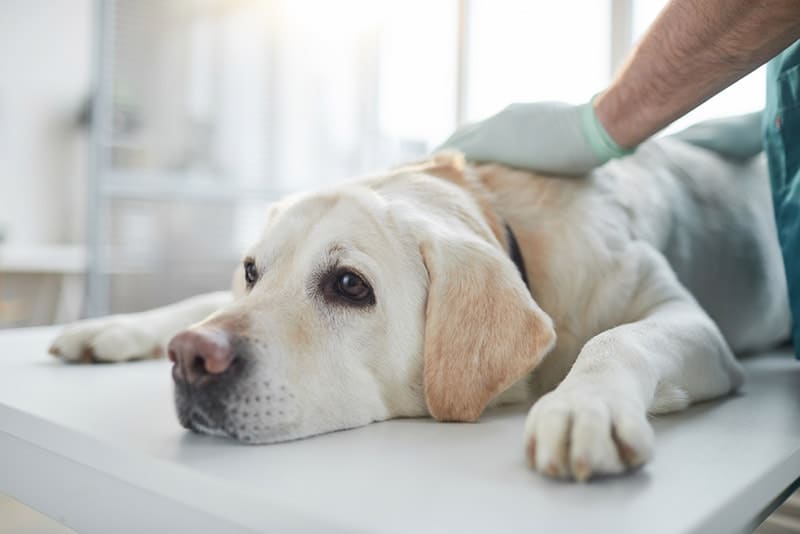
Prevention
Even after the initial incident is resolved, some kinds of stones can also be prevented by feeding a special medical diet going forward. In those with tumors, surgery, and an oncology consultation may be the next step towards treatment. For male dogs with prostate disease, if they are not already neutered, this would be the next step forward to help the prostate’s size decrease.
Regardless of the urinary obstruction cause, monitoring for future urinary obstructive episodes with routine checkups, lab work, and imaging are likely to be even more important for your dog’s health.

Conclusion
If your dog is urinating very little or not at all, there are various reasons this could be occurring. However, regardless of the underlying reason for the blockage, it is a medical emergency. If you suspect your dog is not urinating normally, be sure to contact a veterinary professional right away to have the best chance of helping your beloved canine friend.
Featured Image Credit: Utku Demirsoy, Shutterstock
